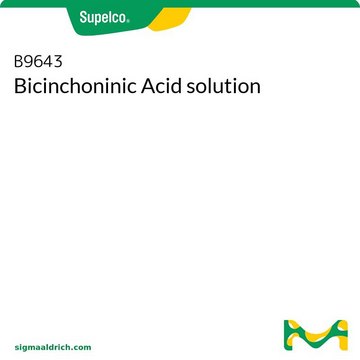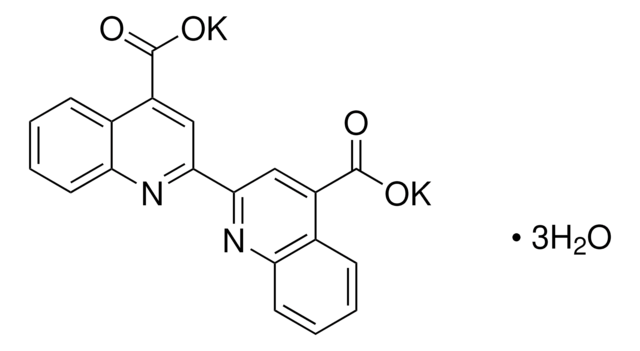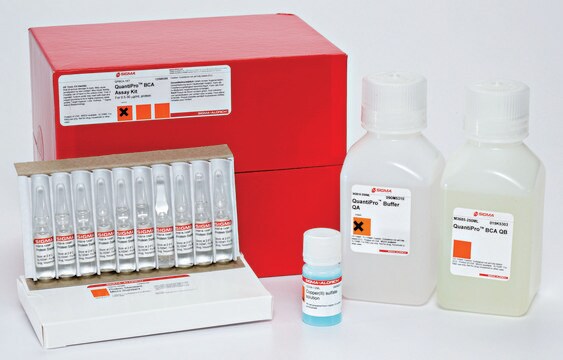Kluczowe dokumenty
D8284
Bicinchoninic acid disodium salt hydrate
≥98% purity (HPLC), powder
Synonim(y):
2,2′-Biquinoline-4,4′-dicarboxylic acid disodium salt, 4,4′-Dicarboxy-2,2′-biquinoline disodium salt, BCA, Disodium 2,2′-biquinoline-4,4′-dicarboxylate
About This Item
Polecane produkty
Nazwa produktu
Bicinchoninic acid disodium salt hydrate, ≥98% (HPLC)
Poziom jakości
Próba
≥98% (HPLC)
Formularz
powder
metody
titration: suitable
kolor
white to light yellow
rozpuszczalność
0.5% sodium bicarbonate: 50 mg/mL
Zastosowanie
diagnostic assay manufacturing
hematology
histology
temp. przechowywania
2-8°C
ciąg SMILES
O.[Na+].[Na+].[O-]C(=O)c1cc(nc2ccccc12)-c3cc(C([O-])=O)c4ccccc4n3
InChI
1S/C20H12N2O4.2Na.H2O/c23-19(24)13-9-17(21-15-7-3-1-5-11(13)15)18-10-14(20(25)26)12-6-2-4-8-16(12)22-18;;;/h1-10H,(H,23,24)(H,25,26);;;1H2/q;2*+1;/p-2
Klucz InChI
FAFVGCAYKZKOPT-UHFFFAOYSA-L
Szukasz podobnych produktów? Odwiedź Przewodnik dotyczący porównywania produktów
Zastosowanie
- Bicinchoninic acid disodium salt hydrate has been used to monitor the levels of reducing sugars, thereby helping in the detection of chitinases.
- It has also been used to determine the amount of cellulose reducing ends (micromoles/g cellulose).
- It has been used for determining protein concentration.
Działania biochem./fizjol.
produkt powiązany
Hasło ostrzegawcze
Warning
Zwroty wskazujące rodzaj zagrożenia
Zwroty wskazujące środki ostrożności
Klasyfikacja zagrożeń
Eye Irrit. 2 - Skin Irrit. 2
Kod klasy składowania
11 - Combustible Solids
Klasa zagrożenia wodnego (WGK)
WGK 3
Temperatura zapłonu (°F)
Not applicable
Temperatura zapłonu (°C)
Not applicable
Środki ochrony indywidualnej
dust mask type N95 (US), Eyeshields, Faceshields, Gloves
Wybierz jedną z najnowszych wersji:
Masz już ten produkt?
Dokumenty związane z niedawno zakupionymi produktami zostały zamieszczone w Bibliotece dokumentów.
Klienci oglądali również te produkty
Nasz zespół naukowców ma doświadczenie we wszystkich obszarach badań, w tym w naukach przyrodniczych, materiałoznawstwie, syntezie chemicznej, chromatografii, analityce i wielu innych dziedzinach.
Skontaktuj się z zespołem ds. pomocy technicznej











